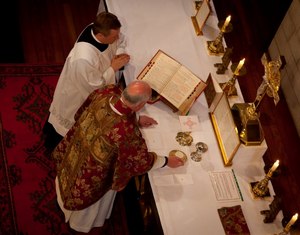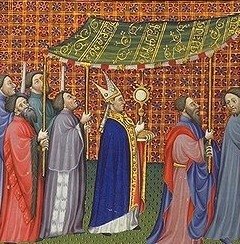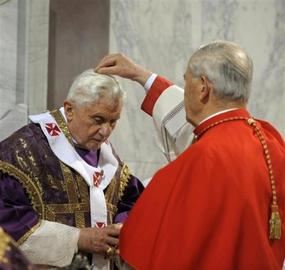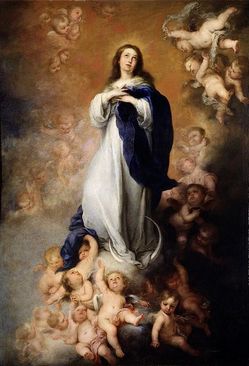 For Catholics it is Sunday, not the Sabbath (Saturday) in the technical sense as it applies to Jewish theology, but it is the day of worship of the One Triune God in the Triumph of death by death itself; it is Sunday which commemorates the Resurrection of Jesus, that is the fulfillment of the Paschal Mystery (life, death, Resurrection and Ascension of the Lord). Sunday is the perpetual Day of the Lord in practice.
For Catholics it is Sunday, not the Sabbath (Saturday) in the technical sense as it applies to Jewish theology, but it is the day of worship of the One Triune God in the Triumph of death by death itself; it is Sunday which commemorates the Resurrection of Jesus, that is the fulfillment of the Paschal Mystery (life, death, Resurrection and Ascension of the Lord). Sunday is the perpetual Day of the Lord in practice.
Tag: liturgy
Lauda Sion Salvatorem: Corpus Christi a Mysterical renunion
The feast of Corpus Christi has a rich fare to savor: prayers, Bible readings, music, and poetic texts. The point of the Church offering us this opportunity to honor the Eucharistic Presence is to extend in our lives a deeper grace given in Communion theology, to have a closer with the Lord in His promised hundredfold. It is, of course, a deepening in our lives what the Lord Himself did and gave to us on Holy Thursday with Eucharist and the priesthood.
The Sequence (the poetry which follows the second lesson at Mass and directly precedes the Alleluia verse), Lauda Sion Salvatorem, is ideally fitting for the sacred Liturgy. Google this masterpiece of poetry expressing theology in a way that stimulates prayer and deepens one’s faith.
The English priest Father Ronald Knox offers a perspective on what we’re doing in observing the great feast of the Lord’s Body and Blood. The following is taken from his meditation on Corpus Christi:
Like the Jewish Temple, the Christian altar is the rallying point of God’s people. The whole notion of Christian solidarity grows out of, and is centered in, the common participation of a common Table. The primitive Church in Jerusalem broke bread day be day from house to house; its stronghold of peace was not any local centre, but a common meal. Christian people, however separated by long distances of land or sea, still meet together in full force, by a mystical reunion, whenever and wherever the Bread is broken and the Cup blessed.
Give your “Amen” to God’s glory
In our continuing reflection on prayer in the letters of Saint Paul, we now consider the Apostle’s striking affirmation that Jesus Christ is God’s “Yes” to mankind and the fulfillment of all his promises, and that through Jesus we say our “Amen”, to the glory of God (cf. 2 Cor 1:19-20). For Paul, prayer is above all God’s gift, grounded in his faithful love which was fully revealed in the sending of his Son and the gift of the Holy Spirit. The Spirit, poured forth into our hearts, leads us to the Father, constantly making present God’s “Yes” to us in Christ and in turn enabling us to say our “”Yes” – Amen! – to God. Our use of the word “Amen”, rooted in the ancient liturgical prayer of Israel and then taken up by the early Church, expresses our firm faith in God’s word and our hope in his promises. Through this daily “Yes” which concludes our personal and communal prayer, we echo Jesus’ obedience to the Father’s will and, through the gift of the Spirit, are enabled to live a new and transformed life in union with the Lord.
Pope Benedict XVI
30 May 2012
Don’t forget the dog at the Liturgy
For you and for many… the Pope reflects
In the days following the Easter celebrations Pope Benedict XVI took time to reflect on through the form of a letter, the liturgical use of the phrase “For you and for many” that is used at Mass. With the third edition of the Roman Missal this phrase has been restored and it is has caused some people to wonder why the change after so many years; the priest had been saying “for all.” The Pope’s teaching is clear to why our liturgical praxis needs to be coherent with sacred Scripture, coherent with the Lord’s own teaching.
Lent 2012: we, prodigal children, can return
Pope Benedict XVI processed from the Benedictine Church of Saint Anselm to the Dominican Church of Saint Sabina on the Aventine Hill. A long standing tradition of the popes, though it was in abeyance for several years until 1979 when John Paul II revived the tradition. The Benedictine monks welcome the Pope and his entourage for a moment of prayer and reflective before processing to the 5th century church of the Dominican Friars where Holy Mass is celebrated with the distribution of ashes. As usual, Cardinal Tomko, the cardinal titular of Saint Sabina’s gave Benedict his ashes. The following homily of the Pope’s focusses on the origins of this humble sign that assists in our recognition of salvation. Is this our recognition, too?
Ash Wednesday is a day of fasting and penance on which we begin a new journey towards the Easter of Resurrection, the journey of Lent. I would like to reflect on the liturgical sign of the ashes, a material sign, a natural element that, in the Liturgy, becomes a sacred symbol, so important on this day that marks the start of our Lenten journey. In ancient times, in the Jewish culture, it was common to sprinkle one’s head with ashes as a sign of penance, and to dress in sack-cloth and rags. For us Christians, there is this one moment which has important symbolic and spiritual relevance.
Ashes are the material sign that brings the cosmos into the Liturgy. The most important signs are those of the Sacraments: water, oil, bread and wine, which become true sacramental elements through which we communicate the Grace of Christ who comes among us. The ashes are not a sacramental sign, but they are linked with prayer and the sanctification of the Christian people. Before the ashes are placed on our heads, they are blessed according to two possible formulae: in the first they are called “austere symbols”, in the second, we invoke a blessing directly upon them, referring to the text in the Book of Genesis which can also accompany the imposition of the ashes: “Remember that you are dust and unto dust you shall return”.
Continue reading Lent 2012: we, prodigal children, can return
Baptism of the Lord, no ordinary feast
 Today the Church in the US celebrates the Feast of the
Today the Church in the US celebrates the Feast of the
Baptism of the Lord, in 2012, the day after the Solemnity of the Epiphany. In other places, like Rome, the Church observed the Baptism of the Lord yesterday as the Epiphany was celebrated on the traditional 12th day of Christmas,
January 6. Today’s feast reminds us that being a Christian is the joy of being “children of God.” During his noontime Angelus Address Pope Benedict said that “God is the origin of the existence of every creature and the Father in a unique way of every human being: He has a unique, personal relationship with him or her.”
At Mass in Rome earlier in the morning the Pope had baptized 16 newborn infants, children of Vatican employees in the Sistine Chapel.
Anton Baumstark: On the Historical Development of the Liturgy
The decision to publish this book in English is exceptional. Anton Baumstark is a pivotal figure in 20th century liturgical studies and widely considered a genius. He set the world on fire for his keen understanding of the sacred Liturgy, both of the East and the West as he offers a lens –a method– for understanding historical (organic) development in the Tradition of the Church. Baumstark keeps the reader grounded in asking the questions which keep us close to the theologia prima, the sacred Liturgy. The serious student in liturgical studies will pay close attention to On the Historical Development of the Liturgy and Comparative Liturgy.
The Forward is written by Archimandrite Robert F. Taft, SJ, from whom I was first introduced to Anton Baumstark.
From the publisher, Liturgical Press:
Anton Baumstark’s On the Historical Development of the Liturgy (1923) complements his classic work, Comparative Liturgy. Together they lay out his liturgical methodology. Comparative Liturgy presents his method; On the Historical Development of the Liturgy offers his model.
This book was written for one audience and valued by another. Written to lead adherents of the nascent German liturgical movement to a deeper religious appreciation of Catholic worship, its methodology and scope have won the appreciation of liturgical specialists for nearly a century. In describing the organic growth of the liturgy, its shaping and distortion, Baumstark’s reach extends from India to Ireland, Moscow to Axum, Carthage to Xi’an. He discusses the influences of language, literature, doctrine, piety, politics, and culture. While his audacity can be breathtaking and his hypotheses grandiose, his approach is nevertheless stimulating. In this annotated edition, Fritz West provides the first English translation of this work by Anton Baumstark.
Trained in classical and oriental philology, Anton Baumstark (1872-1948) was prodigious as a scholar studying the literature, art, and liturgy of the whole church–Oriental, Eastern, and Western. Comparative liturgy, his method for studying the historical development of the liturgy as an organism, has had a lasting influence, notably on the liturgical study of the Christian East. Fritz West, a liturgical scholar ordained in the United Church of Christ, has written numerous articles on liturgical methodology, the three-year lectionary, and worship in his Reformed tradition. He has published two books, The Comparative Liturgy of Anton Baumstark and Scripture and Memory: The Ecumenical Hermeneutic of the Three-Year Lectionaries.
Why is the Immaculate Conception important?
What did we hear today from the sacred Liturgy about the Immaculate Conception of the Blessed Virgin Mary? How close to did you pay attention to the priest praying the Mass prayers on your behalf? What’s the import of the feast? To know the answers we have to look at the texts of today’s Liturgy. Did you notice when the priest prayed:
1. God preserved Mary from every stain of sin by foreseeing the death of His Son Jesus, and so we pray too, that is, we hope to be cleansed of sin and admitted to communion with Him;
2. we profess belief in God’s prevenient grace given to Mary and we hope that He will deliver us from sin;
3. in the Preface, the priest prays that in Mary who was “endowed with the rich fullness of your [God’s] grace … [there is] a worthy Mother for your Son and [which] signify the beginning of the Church; As Pope Benedict said today, “Mary, on the other hand,” he continued, “is Immaculate, free from all stain of sin. The Church is holy, but at the same time marked by our sins.”
4. in her yes to God’s invitation to be the Mother of Jesus, we have the “Lamb would wipe away our offenses”;
5. we pray that the singular grace given to Mary may also be given to us.
This Liturgy is a mix of liturgical, dogmatic and systematic theology. BTW, this is fitting way to celebrate the graces given to our nation.
Benedict on music and Liturgy
Two central interests in the ministry of Pope Benedict are music and the sacred Liturgy; other interests you might say are evangelization, theology and culture. At recent gatherings with the Pope he spoke about music as a concert given by a group of Spanish musicians and then to the bishops of New York State making their pilgrimage to Rome to pray and speak with the Pope about their work. Below are two interesting sets of ideas worthy of reflection:
On music
“…the magic
worked by music, the universal language which can overcome all barriers and
allow us to enter the world of others, of a nation or a culture, at the same
time enabling us to turn our mind and hearts … to the world of God.”
Pope
Benedict XVI to musicians
November 26, 2011
On the sacred Liturgy
“A weakened sense of the meaning and importance of Christian
worship can only lead to a weakened sense of the specific and essential
vocation of the laity to imbue the temporal order with the spirit of the
Gospel. America has a proud tradition of respect for the Sabbath; this legacy
needs to be consolidated as a summons to the service of God’s Kingdom and the
renewal of the social fabric in accordance with its unchanging truth.”




